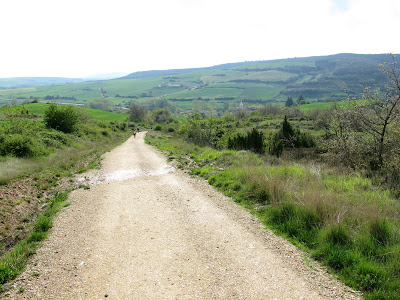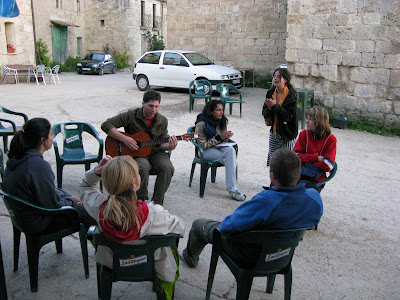160. An early start from Belorado
 161. A view of the C12 hermitage of Our Lady of the Rock, seen while leaving Tosantos
161. A view of the C12 hermitage of Our Lady of the Rock, seen while leaving Tosantos  162. A view from the Camino
162. A view from the Camino 163. Approaching Espinosa del Camino
163. Approaching Espinosa del Camino 164. The church at Espinosa
164. The church at Espinosa 165. Local art
165. Local art 166. Ruins of the C9 Monasterio de San Felix
166. Ruins of the C9 Monasterio de San Felix 167. Approaching Villafranca de Montes de Oca ('Villafranca' indicates the French influence in the village's foundation)
167. Approaching Villafranca de Montes de Oca ('Villafranca' indicates the French influence in the village's foundation) 168. The church in the square in Villafranca
168. The church in the square in Villafranca 169. The road out from Villafranca
169. The road out from Villafranca 170. Two Hungarian pilgrims making the climb up from Villafranca
170. Two Hungarian pilgrims making the climb up from Villafranca 171. A view back on the valley below
171. A view back on the valley below 172. One of many impromptu devotional grottos along the way created by the local residents or visitors
172. One of many impromptu devotional grottos along the way created by the local residents or visitors 173. Monumento de los Caidos: a monument to the victims of the Spanish Civil War 1936-1939
173. Monumento de los Caidos: a monument to the victims of the Spanish Civil War 1936-1939 174. Sepulchre for San Juan de Ortega in the church in the village that bears his name. His remains are, however, buried elsewhere. I had intended to stay at the adjacent albergue. However, the death a few days earlier of its legendary parish priest, great provider of onion soup and other hospitality for pilgrims (and the consequent, hopefully temporary, closure of the albergue), forced us to travel on to Ages.
174. Sepulchre for San Juan de Ortega in the church in the village that bears his name. His remains are, however, buried elsewhere. I had intended to stay at the adjacent albergue. However, the death a few days earlier of its legendary parish priest, great provider of onion soup and other hospitality for pilgrims (and the consequent, hopefully temporary, closure of the albergue), forced us to travel on to Ages. 175. Approaching Ages
175. Approaching Ages 176. The main street in Ages with its two albergues
176. The main street in Ages with its two albergues 177. Dinner in the albergue at Ages. From left: Gabor (Hungary), Agata (Hungary), Michael (Germany), Edina (Hungary) and Phillipe (France)
177. Dinner in the albergue at Ages. From left: Gabor (Hungary), Agata (Hungary), Michael (Germany), Edina (Hungary) and Phillipe (France) 178. The Puente Canto between Ages and Atapuerca (not in current use)
178. The Puente Canto between Ages and Atapuerca (not in current use) 179. Looking back on Atapuerca en route to Burgos
179. Looking back on Atapuerca en route to Burgos 180. A cross, presumably the result of spontaneous religious devotion
180. A cross, presumably the result of spontaneous religious devotion 181. Circle of stones, provenance unknown
181. Circle of stones, provenance unknown 182. Burgos cathedral
182. Burgos cathedral 183. Tympanum detail from the Burgos cathedral
183. Tympanum detail from the Burgos cathedral 184. Dinner in Burgos: Erica (Koln), Rodney (Brazil), Fernando (Valencia) and unknown pilgrim
184. Dinner in Burgos: Erica (Koln), Rodney (Brazil), Fernando (Valencia) and unknown pilgrim 185. Pascal (Switzerland) and Serano (Byron Bay)
185. Pascal (Switzerland) and Serano (Byron Bay) 186. En route to Hornillos, 16 May
186. En route to Hornillos, 16 May 187. Erica on the Camino towards Hornillos
187. Erica on the Camino towards Hornillos 188. Approaching Hontonas where I stayed on the evening of 16 May
188. Approaching Hontonas where I stayed on the evening of 16 May 189. Entering Hontonas, classic Camino village
189. Entering Hontonas, classic Camino village 190. Michael leading the music making outside the albergue in Hontonas after dinner
190. Michael leading the music making outside the albergue in Hontonas after dinner
Greetings from Hotonas on the Meseta, the flat tableland plateau in northern Spain. It runs, more or less, until Leon.
Ages to Burgos, Thursday 15 May
I left Ages yesterday morning for Burgos. We tramped along a very muddy path through fields of wheat with rain threatening but never really developing. Poor signage took us through villages whose bars were not always ready to welcome us. Then we trekked through the suburbs of Burgos to its historic centre. Many pilgrims went onto the municipal albergue 2 kms onwards. I stayed in a very congenial hotel in the centre. I did some more shopping for a gaitor and extra pair of sox and posted more stuff on in disgrace to Santiago de Compostela for collection at journey's end.
I had intended to stay an extra day in Burgos to revive but found it unnecessary and a distraction. A few others are staying a night to explore. I did not even see the interior of the beautiful cathedral, the town's centrepiece. Not as good as Koln's, the loyal Germans say. It shares common design and artisan inputs. That experience can be shared with Ana when we travel here together. Burgos is a wealthy, lively, energetic, stylish and beautiful city. It takes itself seriously. It was firmly on Franco's side in the Civil War, I understand. Much of this region was.
I had a great dinner last night with fellow peregrinos, the best of the peregrino meals I've had on the Camino. All for a modest 12 Euro.
Burgos to Hontanos, Friday 16 May
Trekked through the suburbs of Burgos from 7 am to join wheatfields with some oats and barley, and the slow climb to the Meseta, the start of a new geographical phase of the Camino. This is the bread basket of Spain and makes for peaceful and reflective walking. It is muddy still--such water and rainfall, and the dense green, is wholly unfamiliar to Australian eyes.
Many peregrinos stopped at Hornillas after 20 kms. I want to stay at Boadilla and Carrion del Condes and so went on to Hontonas, a total of 32 kms. It is a classic pilgrim town based largely on the Camino. I'm staying at El Puntido, a comfortable private Albergue.
Other pilgrims
There are so many to mention but a few stand out. I walk quickly with my long legs but was amazed to arrive today just after Sallie, a Canadian widow at least 5 years older than me and much smaller in frame. We left so many youngsters behind. Maurice from France, at 76 and with a slender frame, is just outstanding. We slept cheek to jowl in Logroño-"Bon soir, Paul", "Bon soir, Maurice". Phillipe from France is also so memorable, a horseshoe maker and horseman, but a fuller note here might breach confidences and not do justice to him and his interesting story. The Camino holds many heroes and they each have their undisclosed reason to be here. Some, I suppose, are just masochists.
Death of a Camino hero
The albergue at San Juan de Ortega was closed as we came though it a couple of days ago. Its parish priest served garlic onion soup nightly to pilgrims and is justly famous on the Camino. Sadly, he died a few days ago. He will be greatly missed.
Must run to dinner with friends. Sorry for typing etc solecisms. No spellcheck and unfamiliar keyboard. And pressure on the single computer in the albergue.
1 comment:
Hi Paul
You certainly walking with the best and as you have trained for years it is all paying off.
There is an old saying 'Walk and talk'
How are the underdaks going?
Tony
Post a Comment